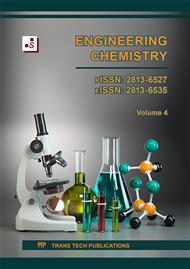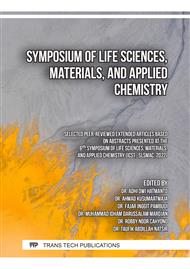[1]
S.N.A.S. Salleh, W.L.W. Johari, N.A.M. Hanapiah, A comprehensive review on chemical compounds, biological actions and potential health benefits of stingless bee propolis, Sains Malays. 51 (2022) 733-745.
DOI: 10.17576/jsm-2022-5103-08
Google Scholar
[2]
A. Sulaeman, A.M. Fikri, N. Kalsum, M. Mahani, Chapter 25 - Trigona propolis and its potency for health and healing process, in: R.B. Singh, R.R. Watson, T. Takahashi (Eds), The role of functional food security in global health, Academic Press, Cambridge, Massachusetts, United States, 2019, pp.425-448.
DOI: 10.1016/b978-0-12-813148-0.00025-6
Google Scholar
[3]
J.A.I. Devi, A.K. Muthu, Gas chromatography mass spectrometry analysis of bioactive constituents in the ethanolic extract of Saccharum spontaneum Linn., Int. J. Pharm. Pharm. Sci. 6 (2014) 1-23.
Google Scholar
[4]
M. Trianto, H. Purwanto, Morphological characteristics and morphometrics of Stingless Bees (Hymenoptera: Meliponini) in Yogyakarta Indonesia, Biodiversitas 21 (2020) 2619-2628.
DOI: 10.13057/biodiv/d210633
Google Scholar
[5]
C. Ignea, E. Ioannou, P. Georgantea, S. Loupassaki, F.A. Trikka, A.K. Kanelis, A.M. Makris, V. Roussi, S.C. Kamprani, Reconstructing the chemical diversity of labdane-type diterpene biosynthesis in yeast, Metab. Eng. 28 (2015) 91-103.
DOI: 10.1016/j.ymben.2014.12.001
Google Scholar
[6]
M.M. Sachitanand, N.G. Hosahudya, Thioacetic acid/NASH-mediated synthesis of N-protected amino thioacids and their utility in peptide synthesis, J. Org. Chem. 79 (2014) 2377-2383.
DOI: 10.1021/jo402872p
Google Scholar
[7]
K. Tayjanov, N.Z. Mamadalieva, M. Wink, Diversity of the mountain flora of central asia with emphasis on alkaloid-producing plants, Diversity 9 (2017) 11.
DOI: 10.3390/d9010011
Google Scholar
[8]
A.T. Getachew, C. Jacobsen, S.L. Holdt, Emerging technologies for the extraction of marine phenolics: opportunities and challenges, Mar. Drugs. 18(8) (2020) 389.
DOI: 10.3390/md18080389
Google Scholar
[9]
L. Paiva, E. Lima, A.I. Neto, M. Marcone,J. Baptista, Nutritional and functional bioactivity value of selected azorean macroalgae: Ulva Compressa, Ulva Rigida, Gelidium Microdon, and Pterocladiella Capillacea, J. Food Sci. 82 (2017) 1757-1764.
DOI: 10.1111/1750-3841.13778
Google Scholar
[10]
J. Cotas, D. Pacheco, A.M. Gonçalves, P. Silva, L.G. Carvalho, L. Pereira, Seaweeds' nutraceutical and biomedical potential in cancer therapy: a concise review, J. Cancer Metastasis Treat. 7 (2021) 13.
DOI: 10.20517/2394-4722.2020.134
Google Scholar
[11]
S.I. Anjum, A. Ullah, K.A. Khan, M. Attaullah, H. Khan, H. Ali, M.A. Bashir, M. Tahir, M.J. Ansari, H.A. Ghramh, Composition and functional properties of propolis (bee glue): A review, Saudi J. Biol. Sci. 7 (2018) 1695–1703.
DOI: 10.1016/j.sjbs.2018.08.013
Google Scholar
[12]
T.G. do Nascimento, R.E. dos Santos Arruda, E.T. da Cruz Almeida, J.M. dos Santos Oliveira, I.D. Basílio-Júnior, I.C.C. de MoraesPorto, A.R. Rodriges Sabino, J. Tonholo, A. Gray, R.E. Edrada Ebel, Comprehensive multivariate correlations between climatic effect, metabolite-profile, antioxidant capacity and antibacterial activity of Brazilian red propolis metabolitesduring seasonal study, Sci. Rep. 9 (2019) 18293.
DOI: 10.1038/s41598-019-54591-3
Google Scholar
[13]
S. Gardini, D. Bertelli, L. Marchetti, R. Graziosi, D. Pinetti, M. Plessi, G.L. Marcazzan, Chemical composition of Italian propolisof different ecoregional origin, J. Apic. Res. 57 (2018) 639-647.
DOI: 10.1080/00218839.2018.1494911
Google Scholar



